Edward Flatau (1868-1932) – pioneer of neurology and neurosurgery. His personal virtues and exceptional knowledge predisposed him to play a leading role. He combined in his personality thoroughness of a scientist and talent of an anatomist with creativity of an experimenter and gift of observation of a great clinician. His fascination in teaching and personal charm attracted young people eager for knowledge and older people immersed in discovering secrets of science. By upholding these values throughout his whole life, he essentially contributed to an incredible flourish of Polish neurology.
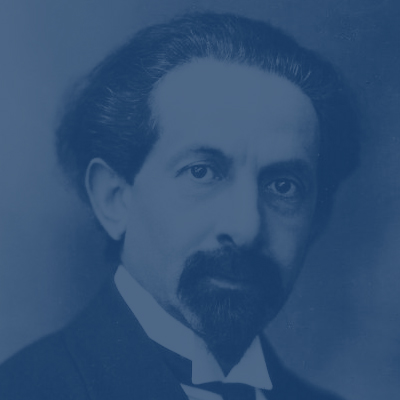
Edward Flatau was born on December 27th, 1868 in Płock. He graduated from gymnasium there and from there he set off to study medicine at the University of Moscow. Already as a student he became known as a talented man. He was mostly influenced by two eminent Russian scientists: the neuropathologist Professor Aleksiej J. Kożewnikow (1836-1902), the author of many papers in neurology, especially dealing with epilepsy and Professor Siergiej S. Korsakow (1854-1900), a psychiatrist who introduced new methods of treatment and care for mentally ill patients, and described a syndrome with memory loss and hallucinations developed as a result of organic brain disease or alcoholic polyneuritis. In 1892, Edward Flatau gained a doctor of medicine’s diploma and a year after graduation he went to Berlin in order to broaden his knowledge of anatomy, histology and pathological anatomy of the nervous system. In Berlin, he was lucky to meet a community of outstanding scientists who embraced him with care and friendship.
Laboratory work can be helpful in deeper understanding of the essence of a disease, in suggesting its genesis and treatment options, and thus can produce results possessing a greater scientific significance
Edward Flatau
In 1894 Flatau captured attention by publishing „An Atlas of the Human Brain and the Course of Nerve Fibers” He created it using a specially constructed camera after precise preparation of fresh brain. He was the first to present in photographs a precise picture of the most important relations between sulci and gyri on the brain surface. This book won such recognition that it was soon translated into Polish, English, French and Russian.
Scientists from Berlin opened wide prospects before a young researcher from Poland. Among them there were the neurologist Professor Goldscheider, the anatomist and histologist Professor Weldeyer, the physiologist Professor Gad, and the neurologists L. Jacobsohon and Minor. Recognizing an unquestionable talent of 26-year Polish scientist, they earnestly engaged in cooperation with him.
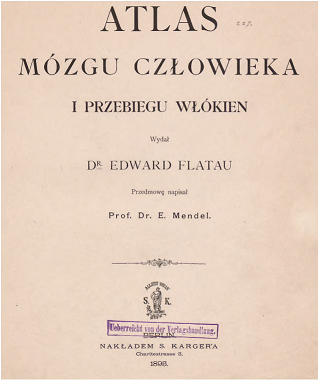
Hence, in collaboration with Professor Goldscheider, he began research of nervous cell pathology. Using different noxious factors (mechanical, thermal, toxic) he studied anatomical and functional changes in those cells caused by an injury. Together with Professor Gad, he carried out many experiments on dogs. In particular, he performed transection of the dog spinal cord and described clinical symptoms caused by this procedure, he criticized the Bestiana-Bruns law about disappearance of patellar reflex after spinal transection. In addition, he conducted numerous experimental studies with Professor Gad, in which he applied electrical excitation of the surface of the transected spinal cord of dogs. These studies indicated that pyramidal pathways of the front and hind leg run slightly apart from one another within the pyramidal route.
Those numerous operations on the spinal cord led him to the conclusion that there were some constant rules according to which different paths run in the spinal cord, in particular, he discovered that long spinal paths had always peripheral position. The rules revealed by him regarding the position of spinal fibers are known as the “Flatau law”. Flatau presented the results of his studies at the meeting of the Prussian Academy of Sciences in Berlin and then this work was defended as the doctor’s thesis at the University of Moscow. This is what Professor Jacobsohn wrote about this work: „Among many articles published by Flatau at that time, particularly one impressed me much because, in a simple and lucky way, it solved the problem of structure of a part of the nervous system”.
In 1896 Flatau together with Professor Goldscheider carried out experimental studies on spreading the Barnim solutions injected into the grey matter of the spinal cord which aimed to elucidate the issues related to hematomyelia. In 1899 in collaboration with his friend Professor Jacobsohn he wrote a handbook of anatomy and comparative anatomy of mammals and drafted an anatomic part of the chapter about peripheral neuritis in a comprehensive classical handbook of pathology by Nothnagel. Finally in cooperation with Jacobsohn and Minor, he published a handbook of pathological anatomy of the nervous system. During his 6-year stay in Berlin, Flatau proved that he was fascinated with science and pursuit of scientific truth. He emanated with his behavior to people around him and drew them to himself. Apparently cold, severe and introverted, he actually was boundlessly friendly, full of camaraderie and care for patients.
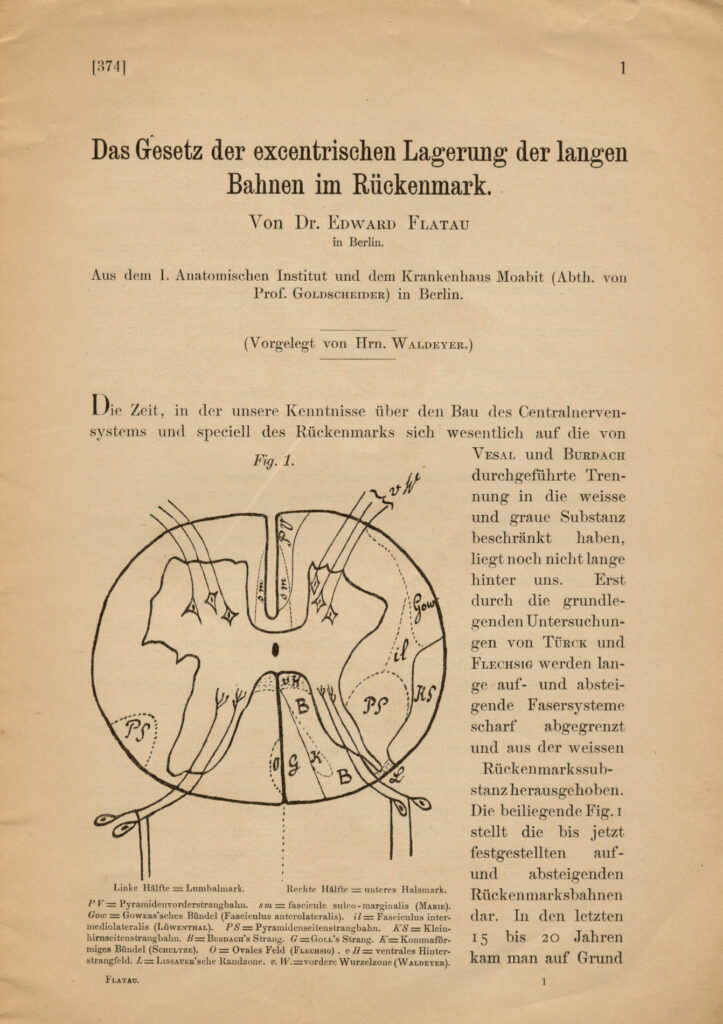
Thus, it was not surprising that young 31 years old but already recognized worldwide Polish scientist was offered the Chair of Neurology at the University of Buenos Aires. He refused because as a righteous Pole he decided to return to Poland to pay his contracted debt of gratitude. With references from German scientists and the Polish neurologist Józef Babiński, he returned to Warsaw in 1899. Unfortunately, he was not offered his own unit to head but was employed only as a neurological consultant at departments of internal diseases headed by Teodor Dunin and Władysław Janowski and departments of surgery led by Bronisław Sawicki and Władysław Krajewski in the Baby Jesus Hospital in Warsaw.
Immediately after coming to Warsaw, he organized a microscopic laboratory in his private apartment using his own resources. “He allotted a part of his own apartment for a microscopic laboratory where we, younger scientists, were trained by Flatau in laboratory work over which he extended his tender care: he checked, advised, corrected in breaks between one patient and another or late in the evening when banquets were finished.” In 1913, Flatau organized a new laboratory at the Psychological Society at 85 Jerozolimskie Avenue. Finally, when the Warsaw Scientific Society gained a new building at 8 Śniadeccy Street, he organized there the Neurobiological Laboratory of the Marcel Nencki Institute and was its head till the end of his life.
Numerous studies on peripheral neuroplasticity, multiple sclerosis, and on the cases of myasthenia provided by Dr Goldfam had been carried out in the Dr. Flatau’s laboratory. In the next years, their results were published in many valuable papers prepared together with Jan Koelich, Władysław Sterling and Natalia Zyberlastówna. Further, in his laboratory, Dr Flatau organized pathological anatomy and histological demonstrations. Although the laboratory was scarce and short in financial resources, it succeeded in training many young physicians-neurologists according to the western European standards. This laboratory brought a refreshing spirit of science most of all because it was led by an exceptional man, full of enthusiasm and passion for science. “We, all young – Herman wrote – his collaborators and students, looked at him with genuine gratitude and sincere admiration. We fondly remember those days which we spent together with him. This laboratory was a destination of numerous pilgrimages of patients from all over the former Congress Kingdom to the acclaimed famous physician.”
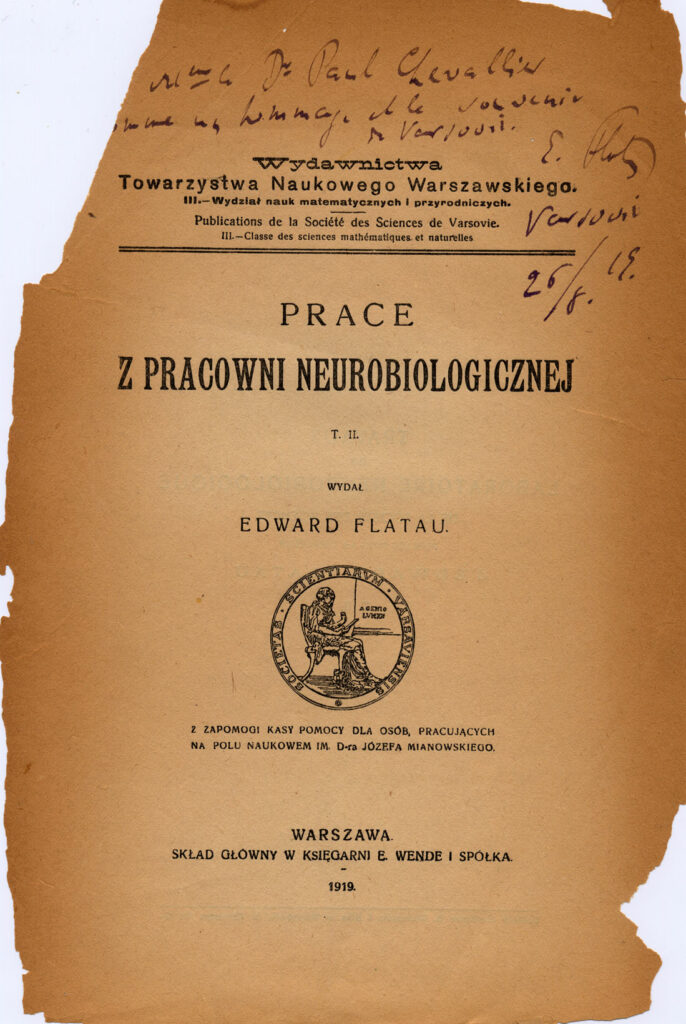
In 1904 after passing a competitive examination, Flatau was employed as the head of the Neurological Department of the Orthodox Jewish Hospital in the Czyste District, taking over the post after the oldest of neurologists at that time Władysław Gajkiewicz who moved to the Baby Jesus Hospital. Then Flatau could combine experimental work of his laboratory with clinical work at the hospital.
„Clinical studies – Flatau wrote – carried out in the last decades brought about nearly complete often meticulously crafted in every detail clinical pictures of both long known and new diseases. However, understanding of the nature of these diseases lags far behind. Thus, treatment of a considerable number of nervous system diseases most often is powerless and fell flat due to insufficiently known pathogenesis.” “In the last 10 years of life of R. Flatau – Professor Herman, his assistant wrote – I was one of his many assistants in the laboratory and hospital, and I had an opportunity to admire every day his exceptional methodical approach to work and outstanding organizational talent. Nothing could disrupt his daily timetable, planned hours of work. This is why Flatau, despite large everyday private medical practice, managed to achieve so much.” He appeared in the Neurobiological Laboratory at 8 Śniadeccy Street at 9 a.m., where he conducted experiments on animals, examined histological preparations, reviewed literature, discussed with his collaborators. At 11.00 he had coffee in a coffee shop nearby, and 15 minutes later went to the hospital in the Czyste at 15 Dworska Street. At the end of his life, he strove for the creation of an independent research unit, a Neurobiological Institute but this goal was achieved only by his disciples.
Professor Edward Flatau was an outstanding scientist, talented clinician and superb teacher. He was distinguished by rarely encountered perseverance in work, tireless energy and remarkable ability to organize team work. Constantly full of creative spirit, he raised still new research problems. For instance, in a classical work on malignant tumors of the central nervous system, he experimentally induced tumors of the brain, cerebellum and spinal cord, using tumor transplants. He carried out observations of development of these tumors, and examined the effect of different chemical and biological factors, especially radon and Roentgen radiation. Based on the experimental work, he used radiotherapy to treat spinal and cerebral tumors either without prior surgery or after their surgical resection, evidencing a beneficial effect of both methods. He was the first who performed operation of a spinal tumor, working together with Dr. Krajewski and Dr. Sawicki. He was also the first promoter of a wide use of radiotherapy for the treatment of nervous system diseases (spinal and cerebral tumors, serous meningitis, multiple sclerosis, neuritis and migraine). He left a legacy of eighty publications presenting a vast material of inventive science, immeasurable collection of research results and observations which brought him widespread fame.
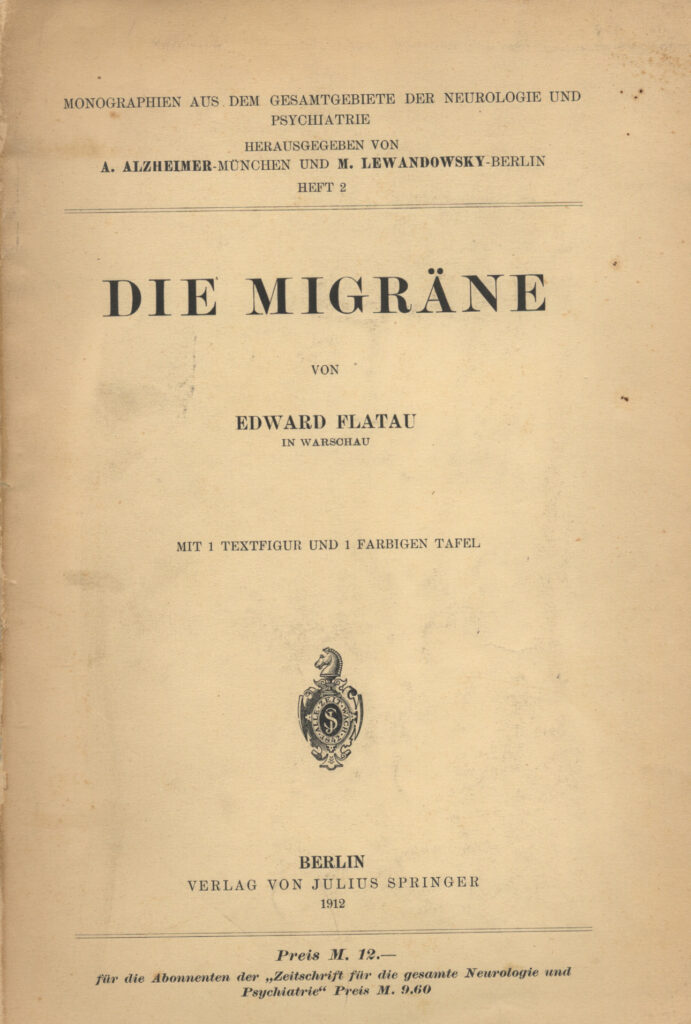
He initially established the Neurological-Psychiatric Section of the Warsaw Medical Society which was then transformed into the Warsaw Neurological Society. He created clinical section at the Social Medicine Society. He was the co-founder of the Warsaw Medical Journal and the Orthodox Jews Hospital Clinical Quarterly.
Professor Paul Schuster from Berlin was right when he wrote in the Jubilee Book on the occasion of the 35th anniversary of scientific activity of Edward Flatau: “When I recall beautiful years of our youth spent with You in Berlin, before my eyes I can see how You, despite always most serious scientific aims, never stayed away from life. You had always your eyes and your heart open to see human affairs while your scientific endeavors were only a part of your aspiration for knowing all human and biological relations.”
Through harmonizing his experimental and pathological anatomy works with clinical observations, he tried to solve three main problems:
- Meninges-related matters,
- Neuritis-related issues,
- Tumor-related issues.
His aim was to treat patients, to bring relief to the sick and suffering. At that time, science did not know the healing power of antibiotics, yet. Flatau with Józef Handelsman began a series of experiments on purulent meningitis. In collaboration with Natalia Zyberlast-Zandowa, he carried out experimental and clinical studies of the reaction of meninges to Mycobacterium tuberculosis and described three types of responses:
- serous meningitis,
- organic tuberculous meningitis,
- chronic tuberculous meningitis.
He evidenced a beneficial effect of X-ray irradiation in serous meningitis. He was the first in Poland to note subarachnoid hemorrhages. He devoted many years of research to multiple sclerosis and disseminated encephalomyelitis. He also described first cases of an epidemic of disseminated encephalomyelitis which was called by scientists “Redlich-Flatau syndrome”.
All his clinical works acquired a renowned position in world literature. Flatau’s original schemes of senses adorn basic handbooks of neurology in many countries even today.
In more than the last decade of his life, cerebral and spinal tumors became the main focus of his interest and research. Apart from clinical observations, he tried to experimentally explore the origin of tumors and therapeutic efficacy of different agents. He was the first who promoted a beneficial effect of the combined treatment with surgery and X-ray or radon irradiation in cerebral or spinal tumors. Flatau was also a precursor of Polish neurosurgery. He first inspired Professor Bronisław Sawicki, Dr. Zdzisław Sławiński and Dr. Paweł Goldstein to conduct cerebrospinal operations. Being a teacher, he gave a great deal of attention to all his collaborators. He was patient and understanding to them, and treated them as family members. They included most of all Professors Maurycy Bomsztajn, Eufemiusz Herman, Władysław Sterling, Jak Koelichen, L. E. Bregman, Natalia Zyberlast-Zandowa, Józef Handelsman and many others. On each Monday, he held traditional meetings of specialized medical doctors in his Department. Besides assistants, they were attended by eminent neurologists, like Samuel Goldflam, Henryk Higier, Zygmunt Byczewski, Maksymilian Biro, and also by medical doctors of other specialties, e.g. Stanisław Kopczyński, T. Kopeć. At those meetings, at the beginning Professor Flatau presented the most recent news from literature and then at each patient’s bed, he thoroughly analyzed each case. He listened carefully to each opinion and explained all doubts.
In 1929, when Professor Flatau celebrated 35th anniversary of his scientific work, his disciples presented him with the Jubilee Book. It contained 68 articles of the best neurologists in the world, of which many were Flatau’s disciples. The following names should be mentioned: S. A. Kinnier Wilson and Frederic Mott from England, Paul Schuster, Bernhard Pollack, S. Kalischer, O. Potzl, Emil Redlich form Germany, Georges Gullain, Th. Alajauanine, Henri Claude form France, Oskar Fischer from Bohemia, Otto Marburg from Austria, E. A. Homen, G. Wangel from Finland, Karl Schaffer from Hungry, W. M. Bechterew, G. E. Szumkow, M. Astvat Satouroff from Russia, M. Minkowski from Switzerland, Casmir Franko-Mavinesco and Sayer from Romania.
„In the morning before starting the everyday work as usual, when we gathered in the Flatau’s private office, Flatau listened to a laudation by Professor Zygmunt Szymanowski; moved, he shook hands with all of us and said: Let’s go to work colleagues”. This simplicity reflects the whole spiritual character of Edward Flatau.
He worked with full dedication to patients until the last days of his life. He died on June 7th, 1932 at the age of 64. He left behind a memory of a man of vast knowledge and unprecedented erudition and of an experienced scientist. Everyone who knew Edward Flatau remained under his spell.
Doctor Z. Wertenstein, a disciple of Maria Curie-Skłodowska, from the Marcel Nencki Institute of Experimental Biology, speaking at his funeral, said: “For almost 20 years I had been the closest neighbor of your workplace, I saw you almost every day, I admired even powerful pace of your work and its enormous efficiency despite so many different duties, which due to the perfect balance of your spirit contributed towards a harmonious whole.”
When he passed away, a huge band of his disciples was struck with overwhelming grief. “We have lost the man –Professor Bornsztajn said – as if carved out from a single block, a man of bold and unbreakable character, who went through his whole life at a steadfast pace. He loved science and striving for scientific truth, radiating with this love to the entourage and drawing them towards him.” He was a man of goodness – but not of an ordinary, small and sentimental goodness. Apparently cold, severe and introverted, actually he had a boundless passion for his friends, disciples and patients belonging to different social groups, nationalities, cultures. He was not only a good man but also a wise man. He understood people, knew their weaknesses, which he usually treated with a smile and leniency. There was only one thing which he did not tolerate – falsity, careerism, corrupt attitude to science, which was treated as a means to get a position. He had only contempt for such people. He created not only an atmosphere of science but also an atmosphere of moral clarity.
Despite his vast knowledge and many successes, he was a humble man. He was aware of his worth, but never was conceited. He was ambitious especially with regard to his disciples, particularly those in whose talent and scientific future he believed. He enjoyed each of their successes. He better remembered the most important works of his disciples then they did. He was a born teacher and leader. Like no one else, he taught the closest, most precise investigation. He was very generous in sharing everything, there was nothing he would jealously guard. Scientific articles that he read usually on Sunday mornings, he suggested to his collaborators with an appropriate dedication. As a result of this work, he created the first true school of neurologists, from which many talented medical doctors of worldwide renown, originated. He never was a member of any political party. He did not emphasize his views but he was a genuine democrat not just in words but also in deeds. He sincerely loved those who helped him in his work.
As Professor Natalia Zandowa remembered her Master, Flatau respected each creative idea. The youngest of his employees could choose any subject of research they wanted. Flatau as an exceptional teacher, discussed with them, with tact showed possible shortcomings of the project and let them develop it on their own. Then, he observed their endeavors with a great interest. For his disciples and friends, he remained an exemplary man. After his death they felt as survivors on an abandoned ship in the sea. It is not surprising then that they needed some time for coming together and promising solidarity in work. One magnificent flame was replaced by a hundred small lights worthy of memory of their Master Edward Flatau.
Today, looking back to the past years, we have the right to ask the question whether we know achievements of so eminent medical doctor as Edward Flatau or if the passing time has blurred the memory of his merits. Do accomplishments of our predecessors which for ages had enriched history of science and were of precious value to the life of our nation, still are of everlasting importance? Can their moral standards uplift contemporary people? We should remember that though Edward Flatau devoted his entire life to science, he was also a kind-hearted man, who worked voluntarily for suffering, abandoned and poor people.
He was an active member of the Social Medicine Society gathering the most progressive Polish physicians. Being sensitive to poverty and social injustice, he participated in many campaigns aimed to bring relief to the needy. He was also a typical humanist, with a passion for Polish literature, poetry and classical music. He was a man of a great modesty and tact from whom we all could learn the principles of good manners.
References:
- Bau-Prussakowa S., E. Flatau, Neurologia Polska, 1937, 473.
- Bomsztajn M., Człowiek i dzieło, Księga Pamiątkowa Edwarda Flataua, Warszawa 1929.
- Bomsztajn M., E. Flatau, Warszaw. Czasop. Lek. 1932 Nr 47.
- Bergman L, Twórczość naukowa E. Flataua, Warszaw. Czasop. Lek. 1932 Nr 47
- Herman E., E. Flatau jako semiolog, Warsz. Czasop. Lek. 1937 Nr 21.
- Higier H., E. Flatau jako klinicysta, naukowiec, Pol. Gaz. Lek. 1932 Nr 47.
- Koelichen J., E. Flataujako klinicysta, Warsz. Czas. Lek. 1937 Nr 21.
- Mackiewicz J., Badania E. Flataua nad nowotworami układu nerwowego, Warsz. Czasop. Lek. 1937 Nr 21.
- Przemówienie nad trumną Edwarda Flataua (Sosnowski J., Orzechowski K., Goldman A., Natanson A., Orliński M., Goldflam S., Dydyński L., Bychowski Z. i inni), Warszawskie Czasop. Lek. 1932 Nr 24.
- Zandowa N., E. Flatau jako nauczyciel, Warsz. Czas. Lek. 1932 Nr 47.
- Konopka S., E. F1atau, PSB T. VII, Kraków 1948.
Prepared by: doc. dr hab. Witold LISOWSKI, “Skalpel” 2013/03 (maj-czerwiec):pismo Wojskowej Izby Lekarskiej w Warszawie.

